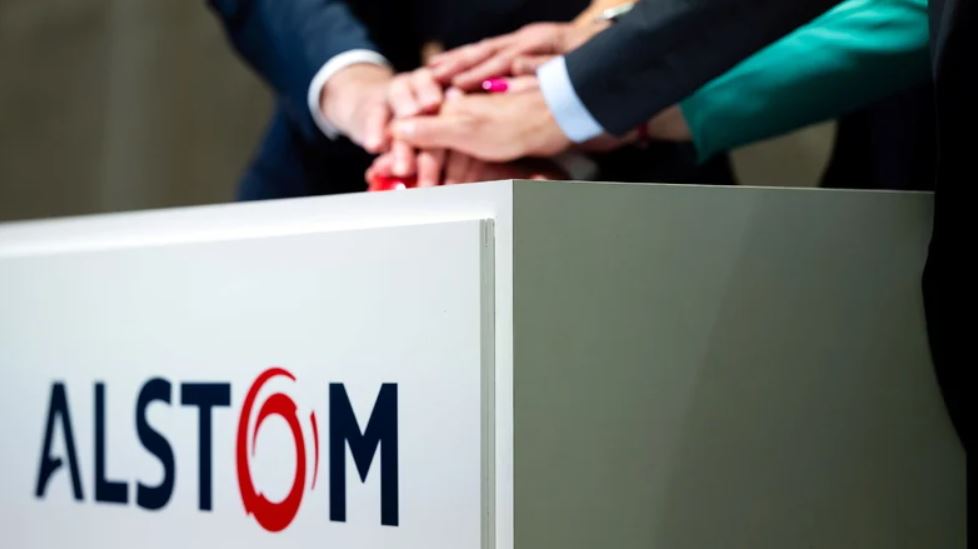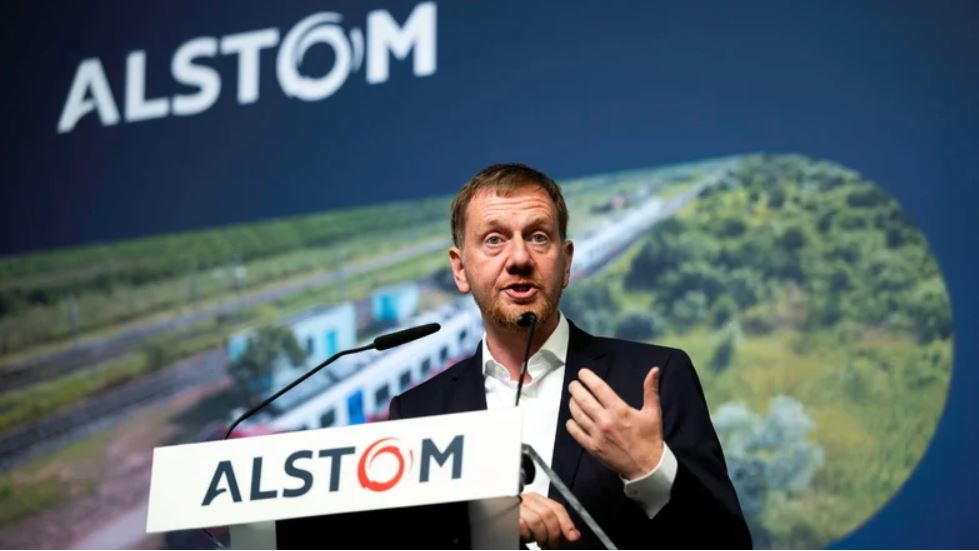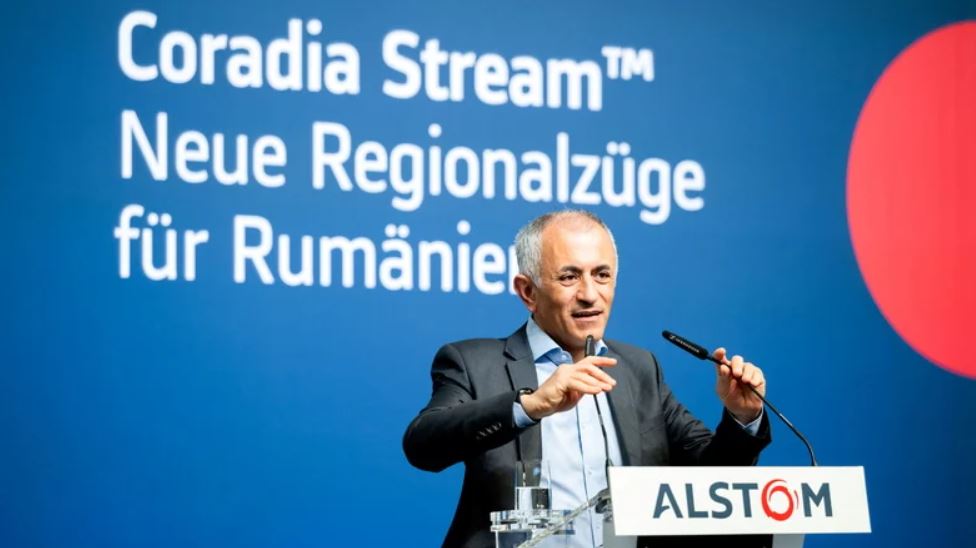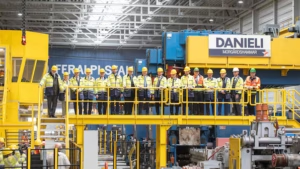Von Miriam Schönbach
Bautzen. Die Bautzener Waggonbauer stellen die Weichen auf Zukunft: Mit einem symbolischen Knopfdruck hat der französische Bahnhersteller Alstom am Standort eine neue Produktionslinie für moderne Regionalzüge in Betrieb genommen. „Das ist die Grundlage, damit wir in Zukunft wunderbare Regionalbahnfahrzeuge aus Bautzen ausliefern können. Diesen Standort wollen wir als festen Bestandteil auf dem Markt etablieren, sodass unsere Wettbewerber schlaflose Nächte bekommen. Nach 180 Jahren Historie wollen wir hier die nächsten 180 Jahre gestalten“, sagte Müslüm Yakisan, Präsident der Region Deutschland-Österreich-Schweiz bei Alstom, bei der Einweihung am 30. Juli 2024.

© Steffen Unger
Auf jener neuen Fertigungslinie werden nun Züge für den rumänischen Regionalverkehr gebaut. Der Auftrag ist aus Sicht von Werkleiterin Beata Krehel eine riesige Chance. „Dieses Ereignis markiert einen wichtigen Meilenstein. Der Rahmenvertrag mit der rumänischen Behörde für die Eisenbahnreform umfasst die Lieferung von bis zu 40 topmodernen Coradia Stream-Fahrzeugen, von denen 34 in Bautzen gebaut werden“, sagt Krehel. Insgesamt stehen hinter dem Auftrag 400 Millionen Euro. Bei den Coradia Stream-Elektrozügen handelt es sich um einen Alstom-Klassiker. Über 4.000 Züge dieser Art wurden bereits an Kunden ausgeliefert.
Bautzen gehört bei Alstom zu den ältesten Standorten
In Bautzen knüpft man mit dem Bau der Regionalzüge an die alte Waggonbautradition an und richtet zugleich den Blick nach vorn. Bisher haben sich die Mitarbeiter hier um die Aufträge gekümmert, die noch aus Bombardier-Zeiten stammten. Der kanadische Schienenfahrzeughersteller hatte seine Oberlausitzer Ableger in Bautzen und Görlitz auf die Herstellung von Stadt- und Straßenbahnwagen spezialisiert. 2021 hatte dann das französische Unternehmen Alstom die Zugsparte von Bombardier übernommen.
Der Standort in Bautzen, der 1846 gegründet wurde, zählt zu den ältesten im Alstom-Konzern. Tradition trifft so auf Moderne – so fasst Beata Krehel die Investition von 2,3 Millionen Euro in die neue Produktionslinie zusammen. „Für den Standort Bautzen stellt ihr Aufbau die Weiterentwicklung der Fertigungskompetenz dar. Die Investition unterstreicht das Engagement Alstoms für eine langfristige Perspektive des Standorts und signalisiert eine neue Ausrichtung auf die Vollbahnproduktion“, sagt die Standortleiterin. Diese solle künftig der Kern im Produktportfolio werden.

© Steffen Unger
Aufgebaut wurde die neue Produktionslinie in nur sechs Monaten. 170 qualifizierte Mitarbeiter werden nun 266.000 Stunden in das Coradia Stream-Projekt stecken. Für dieses Engagement dankt Alstom-Präsident Müslüm Yakisan. „Das ist ein starkes Signal für die Lausitz, für Sachsen und für unser Team in Bautzen. Dieser Standort ist innerhalb der Alstom-Familie ein integraler Bestandteil der weltweiten Fertigungskapazitäten geworden“, sagte er. Die Stadt stehe nicht nur als Synonym für den besten Senf, sondern der Schienenfahrzeugstandort auch für hochwertige Qualität, Präzision, Flexibilität und Know-how.

© Steffen Unger
Die Einführung des neuen Produkts sei für den Konzern ein Symbol des großen Vertrauens, das sich mit einem weiteren großen, hier platzierten Auftrag für den öffentlichen Nahverkehr verbinde. Jenes Milliardenprojekt mit dem Zweckverband go.Rheinland und dem Verkehrsverbund Rhein-Ruhr (VRR) beinhaltet die Lieferung von 90 Nahverkehrszügen für die S-Bahn im Rheinland sowie deren Wartung über einen Zeitraum von drei Jahrzehnten.
„Wir haben nach fast sieben Jahren Arbeit letzte Woche den Zuschlag gewonnen. Das ist der größter Auftrag, den die Alstom Deutschland je akquiriert hat“, sagt Müslüm Yakisan. Endausbau, Test und Inbetriebnahme seien ab 2027 für Bautzen geplant. 2029 sollen die erste Fahrzeuge in Betrieb genommen werden, bis 2033 sollen weitere Bahnen ausgeliefert werden. Das sei ein Generationenauftrag.

© Steffen Unger
Von solchen guten Wirtschaftsnachrichten aus der Oberlausitz wünscht sich Sachsens Ministerpräsident Michael Kretschmer (CDU) mehr. „Dieser Bautzener Erfolg ist hart erarbeitet. Es gab auch große Unterstützung durch die Bundesregierung. Für uns ist es entscheidend, dass wir ein Industrieland mit tarifgebundenen Arbeitsplätzen bleiben“, sagt Kretschmer. Darüber hinaus gehe es darum, die gute Entwicklung im Schienenfahrzeugbau fortzusetzen. Sein Ziel sei ein Sondervermögen für die Deutsche Bahn für Infrastruktur und den Bau von Fahrzeugen.
Verkauft Alstom den Görlitzer Standort?
Während das Bautzener Werk sowohl mit den neuen Aufträgen als auch mit dem Bau von Straßenbahnen für Dresden, Essen, Berlin, Düsseldorf, Duisburg, Magdeburg und Göteborg sowie dem Innenausbau der Doppelstockzüge für die Israelische Staatsbahn und die S-Bahn Hamburggut ausgelastet ist, bangen die Alstom-Kollegen an der Neiße um ihre Arbeitsplätze. Aktuell werden im Görlitzer Werk noch die Wagenkasten-Rohbauten für die Doppelstockwagen für Israel sowie für die Straßenbahnen der Wiener Lokalbahnen sowie für Göteborg, Magdeburg, Dresden und Leipzig gefertigt. Doch was kommt danach?
So rumort es seit Wochen in und außerhalb des Werkes. Eine der letzten Informationen hieß, der Standort soll an ein Maschinenbau-Unternehmen verkauft werden. Das wurde von Müslüm Yakisan am Rand des Bautzener Termins weder bestätigt noch dementiert. „Wir arbeiten mit der Arbeitnehmervertretung, der Landes- und Bundesregierung und vielen Industriepartnern intensiv daran, in und für Görlitz Industriearbeitsplätze zukunftsfähig zu gestalten und langfristig zu erhalten. Wir haben einen Zukunftstarifvertrag, der bis 2026 gilt. Daran werden wir uns halten“, sagt Yakisan. Eine konzeptionelle Gestaltung gebe es aktuell noch nicht. Die Kompetenz des Görlitzer Werks sei aber der Maschinenbau.








